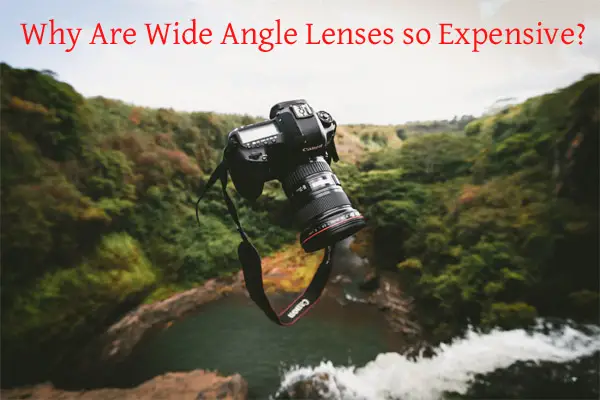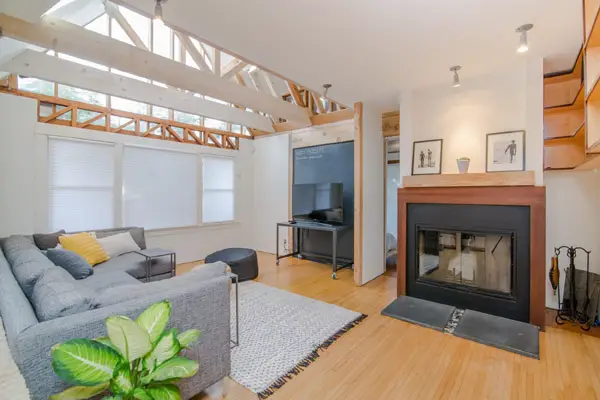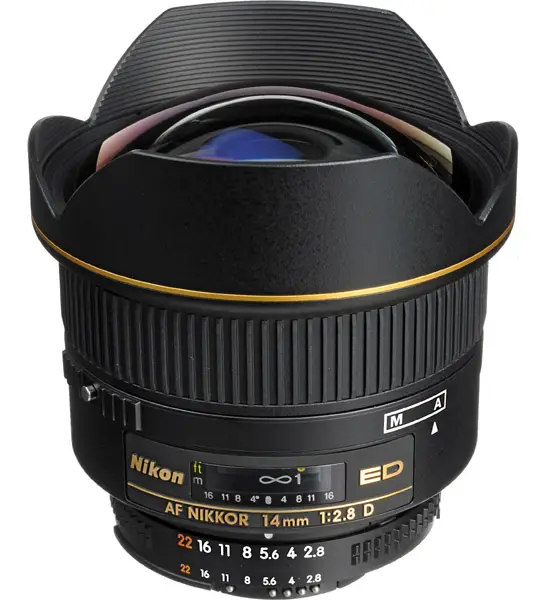If you could’ve taken one more step back, your shot would’ve been perfect. But one more step would’ve sent you plummeting to the bottom of the canyon. You decide it’s time to add a wide angle lens to your collection. But how do you justify the expense? And why are wide angle lenses so expensive anyway?

Manufacturers encounter a few problems when designing wide angle lenses.
The lens typically holds more glass and ends up to be bigger and heavier than a standard lens. This drives the price of the lens up.
But is it really enough to justify the price? Come along with us to learn all about wide angle lenses. What are they for? How are they made? And why isn’t there a cheap version?
What Are Wide Angle Lenses?
The focal length of standard lenses falls between 35mm and 70mm. The most common standard lens is 50mm. Because these focal lengths most closely mimic what the human eye actually sees, they are also called normal lenses.
The technical definition of a standard lens is one whose focal length matches the diagonal of the film or image sensor. On a full-frame 35mm camera this equates to about 43mm. You can find lenses built closer to this focal length, but 50mm tends to be more popular.
Wide-angle lenses have a shorter focal length. They allow the photographer to capture a wider scene. Landscape photographers love them for capturing vast vistas. Real estate photographers use them for capturing entire buildings in one image or when photographing indoors. Rooms are impossible to capture when you can’t back up far enough to see the whole room in your 50mm view.
In the photo below, you could take a photo of the couch or the fireplace, but not both, with a longer focal length. To capture such a wide range, you need a wide angle lens.

Technically, anything shorter than 35mm is considered a wide angle lens. And anything less than 24mm falls into the ultrawide category. Wide angle lenses can go down to 6mm or even shorter for specialty lenses — although there will be significant distortion.
In short, wide angle lenses are useful whenever you want to capture large subjects or need to shoot in close quarters.
Why Isn’t There a Cheap Version?
Admittedly, camera lenses are not cheap. But if you’re willing to sacrifice speed, auto-focus, or optical quality, among other things, you can find a budget lens for most lens categories and focal lengths. On top of that, there are those rare lenses whose quality for the price is mind-blowing.
For example, the nifty-fifty. Canon’s 50mm prime lens that appears in nearly every Canon photographer’s bag. Currently, the price for the f/1.8 STM version is around one hundred dollars and it remains fairly stable. If you have to have the L version, you can get the 50 mm f/1.2 L USM on sale for about 10x that value. But since the quality of the f/1.8 version is so good, you can see why most people stick with this basic 50mm.
However, dig all you like and you won’t be able to find a similar deal for a wide angle lens. There are a handful of options on the budget end of the scale, but they all sacrifice something major. Few are fit for the needs of an amateur photographer and really offer nothing to a serious one.
The question is, why? Is it inherently that much more expensive to build a wide angle lens?
Let’s find out.
What Makes One Lens More Expensive Than Another?
There are a few factors that affect the production cost of a lens. Let’s break it down.
Lens Production
One of the wonders of the modern world is the ability to mass-produce items on an assembly line. Automation takes care of many small tasks when assembling products. This cuts down on the human element, thus slashing production costs dramatically.
However, there is a lot about building camera lenses that still requires the human touch. Automation is used where possible, but some components still require the expertise of a human hand. Thus, the price of labor for assembling the lenses drives up the price. Even when automation or machinery is used, everything must be extremely precise.
The factory environment is also important. Something as trivial as a speck of dust landing on the components before they are sealed can compromise the lens. For this reason, the factory must be kept as sterile as possible.
Lens factories are probably cleaner than your dinner plate — but we still wouldn’t recommend eating off the floor. Maintaining this environment is tedious and slows down production, further driving up prices.
Now consider this, standard lenses are typically thought of as an all-purpose lens. They are excellent for portraits, and you can even use them for landscape photography and closeups. As such, they are in high demand.
Producing more lenses of a certain type reduces production costs. The cost of the research and development that went into the lens as well as setting up the factory to build them is spread out over more sales.
Wide angle lenses do not have this advantage. Demand is lower, causing production costs to rise.

Design
Another factor is the design of the lens. A simple design, like the nifty fifty, is easy to build and doesn’t require extra parts to ensure an in-focus image falls directly on the sensor.
What are we talking about? Check this out. The focal length of a lens is determined by the distance between the camera’s sensor and the optical center of the lens when the subject is in focus. Thus for a 50mm lens, there is a distance of 50mm.
DSLRs require space for the mirror to flip. The necessary space varies depending on the manufacturer, but a typical range is between 42 and 45mm. This means that there isn’t enough space in shorter focal lengths. The image that falls on the sensor can never be in focus.
Manufacturers get around this by using a retrofocus lens design. Stated simply, it’s a second lens that adjusts the focus point, allowing it to fall on the sensor. Thus, at it’s most basic, it makes sense that a wide angle lens would be at least twice as expensive as its standard counterpart, considering that it has twice the glass.
However, a second lens adds more problems. Every piece of glass adds distortion or aberrations to some extent. The more glass, the more aberrations which have to be adjusted for, further affecting the price.
Research and Development
There is also a lot of research and development that goes into making each lens. First, the R&D department studies current photography trends. What are photographers looking for? What kind of images do they want to produce and what capabilities do they require from a lens to do it?
Companies also need to be aware of what their competitors are doing. When a competing camera company comes out with the next big thing, they can’t be far behind or they may lose even the most loyal of customers.
The R&D department is also tasked with fixing problems. How can they reduce the optical aberrations in a wide angle lens? How can they fit all the necessary elements into the smallest and lightest package possible? Can they use a different material to solve these problems?
The R&D department is constantly striving to answer these questions and more. An unfortunate side effect is that all of that costs money. As they are more complicated lenses, wide angles can require additional research, further adding to the cost of the lens.
Cost of Materials
The glass used in lenses has to be high-quality. Imagine sticking regular window glass in a lens. Your image wouldn’t come out quite how you expected. However, high-quality glass doesn’t come cheap.
On top of that, a wide angle lens requires more glass than a standard 50mm. In order to get the required range of view the glass needs to bulge out somewhat. Some lenses handle this internally but you’ll notice that many of the extreme ultrawide angle lenses sport a bulbous lens on the front like one below.

And that’s just the glass. There are also other elements necessary to create a wide angle lens that need to be larger to allow for the bigger field of view. And remember there are two lenses in there so you need at least twice as much space. This means that the lens is getting bigger and heavier.
But then things start getting too big and heavy, which means that wide angle lenses (at least the quality ones) are built with different materials aka more expensive materials. Plus, there is more research and development required to discover better ways to address these issues.
Are Wide Angle Lenses Worth It?
So why are wide angle lenses so expensive? Well, put everything we talked about together and, yes, it is innately more expensive to produce a wide angle lens than a standard lens like a 50mm.
Should you invest in one?
That depends on the type of photography you’re doing. If you do mostly portraits, don’t waste your money. But if you want to do any kind of real estate photography, or shoot expansive landscapes, you’re going to want to save up for a quality piece of glass.
Click on the following link for information on the best wide angle lens for landscapes.









7 comments